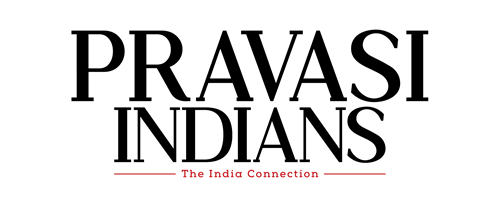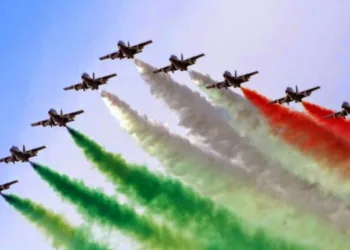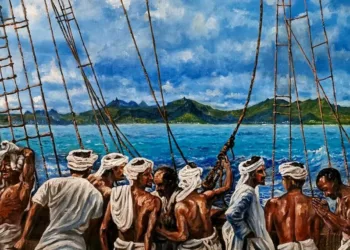Within hours of Donald Trump being sworn in as the 47th US President, uncertainty looms over the 5.2 million Indians living in the United States. From deportations and rising anti–H1B visa sentiment to Trump’s mercurial temperament, there is growing concern—not just among the diaspora, but on both sides of the Atlantic.
President Donald Trump embraced — and even courted — Indian Americans afresh after his big electoral win. A little over three months into his second term as POTUS (President of the United States), however, the euphoria has dissipated. It had started well for Indian Americans, who are among the highest-earning ethnic groups in America, with the nomination of Kash Patel, a prominent lawyer and former federal prosecutor, to the top seat at the Federal Bureau of Investigation (FBI) and the elevation of Jay Battacharya, a physician-scientist described sometimes as an ‘unusual pick’, to lead the nation’s top medical research agency. Trump also nominated Harmeet Dhillon to head the Department of Justice’s Civil Rights Division, much to the chagrin of some. He appointed venture capitalist Sriram Krishnan to an artificial intelligence advisory role, even as Indian American Usha Vance basked in the glory of becoming the Second Lady of the United States. In her all-pink outfit and her “loved up” reaction to Vice President J.D. Vance taking oath as Vice President left netizens in awe.
Additionally, Tulsi Gabbard, a Hindu from the Pacific Islands, was confirmed as US Director of National Intelligence (DNI), though she was seen as one of the most controversial picks for the job by both Democrats and Republicans. She is now the highest-ranking Pacific Islander American government official in US history and the youngest person to serve as DNI and the first millennial to hold the office. President Donald Trump also appointed three Indian Americans as his special assistants dealing with national security, media, and personnel matters. Ricky Gill is handling relations with India at the National Security Council as the senior director for South and Central Asian affairs; Kush Desai is the deputy press secretary; and Saurabh Sharma is in the Presidential Personnel office.
In fact, one of the most talked-about appointments by Trump, while he was still President-elect, was that of Indian American entrepreneur Vivek Ramaswamy, to co-lead the new Department of Government Efficiency (DOGE) alongside Elon Musk, the richest man on Earth. Trump made the announcement on November 12, 2024, indicating that DOGE and its leadership, Musk and Ramaswamy, would regulate government spending in a surprising move away from how previous new administrations were organized. Together, these two wonderful Americans will pave the way for my Administration to dismantle Government bureaucracy, slash excess regulations, cut wasteful expenditures, and restructure Federal Agencies — essential to the Save America Movement, Trump wrote, “I look forward to Elon and Vivek making changes to the Federal Bureaucracy with an eye on efficiency while simultaneously making life better for all Americans.”
The move was seen as a continuation of Trump’s relationship with the 39-year-old Ramaswamy, who had bowed out of the race to become the next president of the United States in the 2024 elections and endorsed Trump. Ramaswamy, a biotech entrepreneur, was reportedly once under consideration for vice president.
However, within hours after President Trump’s swearing-in as the 47th US President, Ramaswamy parted ways with DOGE and announced that he would not co-head the department with Musk. The speculation is rife that Ramaswamy had to pay a heavy price for his comment on X on H1-B visas, although he has vehemently denied all reports of bad blood between him and Musk. Three months later, as DOGE has come to be disdained by a significant number of Americans, Ramaswamy’s decision appears to have been a prudent one in hindsight.
While Ramaswamy has now thrown himself head-on into the race to be the next Governor of Ohio, it remains to be seen whether he will receive the backing from the White House that he desperately needs. Although it is too early to predict Ramaswamy’s newest foray into politics, the over 5.2 million Indians in the United States are on tenterhooks, flustered as to react to the Trump presidency so far. A well-known crypto advisor, who spoke on the condition of anonymity, said, “Even the most prosperous among us are finding it hard to make sense of what is happening. The more you know, the less sense it makes.” When asked about President Trump’s desire to make America the crypto capital of the world, he was not very hopeful about even-handed regulations coming out of the White House in the near future. Sudeep Suratwala, an established hotelier with a chain of hotels across the West Coast, expressed the view that the only class likely to benefit from the current volatility is those with generational wealth, a group that is taxed at much lower levels. “For everyone else, there seems to be no relief in sight, even as we are still reeling from the impact of COVID-19. If we order parts, it still takes months for them to arrive, and now, with the tariff war, we have given up hope of getting parts or making any renovations or expansions,” Suratwala said.
Keeping in view how powerful the Indian American community is in the United States, such sentiments matter. While they make up only 1.47 percent of the US population, the Indian diaspora pays approximately 6 percent—or nearly $300 billion—in income taxes each year in the US. Indians also have the highest median household income in the US, at $126,705. There is even a term for them: Indian American exceptionalism. For all the pandering and “bromance” between President Trump and India’s Prime Minister Narendra Modi, the emerging picture—especially after the onset of the trade wars—is that even as Indians see opportunities in the upended world order, the Indian diaspora is bewildered. They have good reason to be so. Given that among all people of Indian origin, 34 percent are US-born and 66 percent are immigrants, the touchiest topic for immigrants is the H1-B, O-1, and other visa types which allow US employers to hire foreign workers in speciality occupations. Ever since Trump won in November, there has been a non-stop media circus surrounding the program. Voices opposing the H1-B visa program have been growing louder, with everyone, including Ramaswamy, getting sucked into the vortex. As high as 73 percent of Indian immigrants are on the H1-B visa, a category that allows people with in-demand expertise to live and work in the US. Proponents claim it is critical to the US economy, enabling companies to attract highly skilled talent, while opponents argue that it is being exploited by companies to reduce labour costs and displace American workers rather than addressing genuine skill shortages.
The cacophony grew so loud that President Trump felt compelled to speak out in favor of the program. By doing so, Trump bought some more time, but there continues to be simmering discontent within his ranks that threatens to escalate into a crescendo of voices against it. The increasing anti-H1-B sentiment from far-right activists and conservative commentators, like Laura Loomer and Steven Bannon, coupled with President Trump’s mercurial temperament, provide ample reason for concern. Additionally, many have taken offense on being labeled ‘third world invaders’ and ‘cheap labour’ by Loomer.
Adding to the chaos are the shocking images of treatment meted out to a batch of 104 Indian immigrants deported by the US in a military aircraft to Amritsar on February 5. Deportations should not come as a surprise given that the number of Indians deported from the US was highest during President Trump’s first term, peaking at 2,042 in 2019. However, it is the handling of the process that is alarming people on both sides of the Atlantic. According to the Ministry of External Affairs, around 388 Indian nationals have been deported from the US since January 2025, and US Immigration and Customs Enforcement authorities have informed India that an additional 295 individuals are detained in their custody with final orders of removal. In a statement tabled in the Lok Sabha, Minister of State for External Affairs Kirti Vardhan Singh stated that the ministry has strongly registered its concerns with US authorities regarding the treatment of deportees on the flight that landed on February 5, particularly with respect to the use of shackles, especially on women.
He added that the need to promote safe, orderly, and legal migration while cracking down on illegal immigration networks was discussed during the recent visit of the Prime Minister to the US on February 12-13. It is also worth mentioning that Indian Prime Minister Narendra Modi’s visit to Washington in February lacked the pomp of a state visit; it was best described as a working visit.
Apart from deportation, it is not surprising that racism in the US is becoming more pronounced and blatant. Stories like that of Lilly Singh, an Indian American mother of a toddler, who was admonished for speaking in her native language by a white man in a public park in New York, are becoming commonplace. Detailing her experience, she said: “My family and baby were enjoying the cherry blossoms while speaking to each other in our own language. A white man came up to my face, stood less than six inches away, and yelled, ‘You have to talk in English here, or else ICE will come and get you.’” Recalling a similar experience in 2018, Aditi Roa said: “I was in the city to see the Independence Day fireworks. One person stopped in front of me and said, ‘Why are you here? It’s not even your Independence Day.’” But Aditi gave it back when she pointed out that the British invaded India before they came to this land, leaving the man speechless. Crystal Singh noted, “Racial issues are already worse. White supremacy, neo-Nazis, KKK, and others are all on the rise. They are getting bolder each day. There have been several Nazi rallies in numerous states already.”
A mother who wished to remain anonymous expressed her anxiety about her upcoming visit back to India, stating that she hasn’t slept for days. “My husband has a Green Card, but I am on Green Card Advance Parole (AP) as my application (Form I-485) is pending. Even immigration lawyers cannot conclusively tell me that I will be allowed back in the US if I travel now,” she said, adding, “I haven’t seen my family for the last three years and had been saving up to go this year.” Mala Das, a Green Card holder, was questioned for hours when she recently returned. She said, “Personally, I would absolutely not travel on an AP in this political climate. AP entry is among the highest categories chosen for secondary inspection.” Meanwhile, there have been reports of ICE stopping brown-skinned individuals regardless of whether they are US citizens or in the country in other categories. It is no longer surprising to find parents ensuring their teenage children carry their ID cards or passports on their person in case they are stopped and questioned.
Indian Americans are delaying travel out of the US, even for attending weddings or funerals of loved ones, due to apprehensions whether they would be able to return. Similarly, they are postponing bringing elderly parents to the country. For hundreds of thousands of Indian Americans, it feels reminiscent of the lockdown days of the COVID-19 pandemic when all forms of social interaction were restricted. Not surprisingly, immigration lawyers are inundated with calls from Indian Americans seeking to understand the new requirement that some foreign nationals staying in the U.S. for 30 days or more must register with the U.S. Citizenship and Immigration Services. This includes individuals who did not register and were not fingerprinted when applying for a visa. This requirement went into effect on April 11, 2025, prompting a rush particularly for children who are within 30 days of their 14th birthday and elderly individuals whose age renders them unable to be fingerprinted. Those who fail to register may face fines, imprisonment, and potential removal proceedings, leading many to wonder how this will apply to a child who just turned 14 or an elderly person who cannot be fingerprinted.
Then there is the whole birthright citizenship saga which included those who rushed for pre-term C-sections, fearing the implementation of President Trump’s executive order ending birthright citizenship. Meanwhile, expectant parents in the US are anxiously watching as multiple judges block Trump’s attempts to erase birthright citizenship, which is guaranteed by the American Constitution. This legal uncertainty is also causing sleepless nights to over one million Indian Americans who are on the waiting list for a Green Card. If one believed that at least the ultra-rich are rejoicing and seeing the silver lining in what is unfolding at the White House and Mar-a-Lago, they would be mistaken. The well-off, including Indian Americans born in the US, are equally panicky. Despite the notion of Indian American exceptionalism, the majority of them tend to be younger. In fact, half of them are children of an older generation that obtained citizenship through naturalization after immigrating to the country barely a generation ago and thus do not benefit from wealth accumulated by past generations.
For the 5.2 million Indian Americans, who are becoming increasingly influential—with 80 percent holding a university degree and as a cohort earning twice the national average—the “America First” war cry is not well received. The Economist reported that according to a Carnegie Endowment survey, a think tank in Washington, the proportion of Indian Americans identifying as Democrats is 47 percent, down from 56 percent in 2020. However, the data show that despite this decline, the group is not becoming more right-wing. The proportion of Republican voters has barely changed; instead, more members of this diaspora are declaring themselves as independents. The survey indicates that many Indian Americans are concerned about issues that President Trump is unlikely to address. A majority, 82 percent, want stricter gun laws, and 77 percent believe climate change is important. At the end of Trump’s first term, only 33 percent approved of his handling of the India-America relationship. Another Carnegie report revealed this month that Indian Americans rate President Biden’s record as better than Trump’s. According to The New York Times columnist David Brooks: “It’s time for a comprehensive civil uprising. Trump is about power. The only way he’s going to be stopped is if he’s confronted by some movement that possesses rival power.” But amidst the gloom, there are still pragmatic voices like that of Dr. Nihit Gupta, a child psychiatrist from West Virginia, who opines: “Every few years, things get flushed out in the form of recession. It happened in 2008-2010 when many desi got the short end of the stick. The same is happening now…”
Blurb-1
However, within hours after President Trump’s swearing-in as the 47th US President, Ramaswamy parted ways with the Department of Government Efficiency (DOGE) and announced that he would not co-head the department with Musk.
Blurb-2
While the Indian American community is in the United States make up only 1.47 percent of the US population, the Indian diaspora pays approximately 6 percent—or nearly $300 billion—in Income Taxes each year in the US.
Blurb-3
Adding to the chaos is the shocking treatment meted out to 104 Indian immigrants deported by the US in a military aircraft to Amritsar on Feb 5, 2025. Around 388 Indians have already been deported from US since Jan 2025 as per the External Affairs Ministry. The US Immigration authorities say another 295 Indians are facing removal.
Author’s Bio: The author is a New York-based freelance journalist








